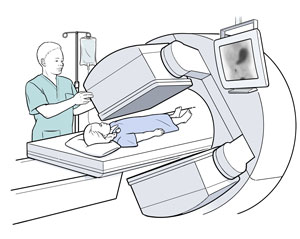A
B
C
D
E
F
G
H
I
J
K
L
M
N
O
P
Q
R
S
T
U
V
W
X
Y
Z
Click a letter to see a list of conditions beginning with that letter.
Click 'Topic Index' to return to the index for the current topic.
Click 'Library Index' to return to the listing of all topics.
Having a Meckel’s Scan (Child)
A Meckel’s scan is an imaging test used to detect a Meckel’s diverticulum. This is a small, abnormal pocket in the wall of a child’s small intestine. It's the most common birth defect of the digestive tract.
What to tell the healthcare provider
Tell your child’s healthcare provider about any new symptoms your child has, such as a recent fever. Also tell the provider if your child has had a medical test that uses barium within 48 hours before the scan.
Getting your child ready for the procedure
The healthcare provider will talk to you about how your child should get ready for a Meckel’s scan. It’s important to talk with your child about the scan. Give a simple explanation about why the scan is needed. Explain that it's important to stay as still as possible during the scan. You can assure your child that you will be nearby the entire time, even if for a short time you can’t be in the same room. You may want to bring a favorite book or toy to use while your child is having the scan. Most hospitals also have DVD players.
Also make sure to:
-
Continue to give your child any medicines they normally take, unless the healthcare provider gives you other directions.
-
Make sure your child does not eat or drink anything for 4 to 6 hours before the scan. You may want to bring a snack or drink that your child can have right after the exam.
-
Give your child H2 blocker medicine as directed, if it is prescribed. This medicine can help the scan technician get a clearer image.
On the day of your child’s procedure
The entire procedure should take about 30 to 60 minutes. A typical scan goes like this:
-
Your child will be awake during the procedure. Let the healthcare provider know ahead of time if you think this may be a problem.
-
An intravenous (IV) line will be placed into your child’s arm, hand, or foot. Your child will feel a pinch when the needle is inserted.
-
Your child will lie down on the exam table. A camera is placed above the table. It will be put very close to your child, but it won’t touch them.
-
Radiotracer will flow through the IV line. The camera will take photos. It will not hurt.
Ask the healthcare provider if you have any questions about what to expect during your child’s scan.

After your child’s procedure
You and your child should be able to go home soon after the scan. A radiologist will look at your child’s scan. The radiologist will send a report of the scan to your child’s healthcare provider. Your child's healthcare provider will review the radiologist's report with you and discuss treatment choices.
Follow-up care
The scan may show that your child has a Meckel’s diverticulum. If so, your child may need surgery to repair it. If the scan does not show that your child has a Meckel’s diverticulum, your child may need other tests to find the source of their bleeding.
Meckel’s scans are not perfect. In a small number of cases, they don’t show a Meckel’s diverticulum that is there. In other cases, they can show what looks like a Meckel’s diverticulum but isn’t. The scan gives information to help guide your child’s diagnosis and treatment. But your child may need other tests.
Make sure to keep all appointments. And make sure to follow all the healthcare provider’s directions about managing your child’s condition.
Online Medical Reviewer:
Neil Grossman MD
Online Medical Reviewer:
Rita Sather RN
Online Medical Reviewer:
Tara Novick BSN MSN
Date Last Reviewed:
12/1/2022
© 2000-2024 The StayWell Company, LLC. All rights reserved. This information is not intended as a substitute for professional medical care. Always follow your healthcare professional's instructions.